The role of human of the stone age in the death of the mammoth faunal complex
Publ ID: 1454015717-292
УДК 902/904 (477.54)
THE ROLE OF HUMAN OF THE STONE AGE IN THE DEATH OF THE MAMMOTH FAUNAL COMPLEX
_______________________
Yuriy Alexandrovich Kolovrat-Butenko
(Orcid ID: 0000-0002-3294-3308, Researcher ID: G-9509-2016)
Peter Academy of Sciences and Arts,
Zmiev Scientific Local Lore Society
Daria Igorevna Bedner
Zmiev Lyceum № 1 named after Z. K. Slyusarenko
Relevance. The characteristic animal of the Pleistocene time of the upper reaches of the Seversky Donets, which gave the name to the whole faunal complex, was the woolly mammoth Mammuthus primigenius Blum. (legacy name Elephans primigenius, Mammuthus chosaricus). In addition there dwelt the species Archidiscodon gromovi Garutt et Alexeeva, Archidiscodon meridionalis Nesti, Archidiscodon trogontherii Pohlig. Mammoths (Fig. 1) widely spread in Europe since the beginning of the Rissian time. However, in the light of discoveries in the late twentieth century L. I. Alekseeva believes that it is possible to expand the chronological framework to the Mindel-Riss and, presumably, to the later stages of glaciation signalisierung [1, p. 9, 10, 13].
Near Zidki village during the operation of the dredge by a local A. V. Soldatenko were found mammoth teeth. The tibia bone (Fig. 2) of the mammoth in the emission of the same dredge was found by the resident of Zamostya A. V. Babich. Under Mokhnach village in the channel of the Seversky Donets was found the Tusk of a mammoth by M. I. Sayanyy (Fig. 3) [22, p. 8]. The mammoth tooth was found during one of the archeological expeditions of Y. I. Krasyuk (Fig. 4). The same researcher have found the horn of a woolly rhinoceros Coelodonta antiquitatis Blum. (Fig. 5) and the shoulder bone of a wild ox Bos primigenius Taurus L. (Fig. 6).
The range of the mammoth occupied a vast territory (Fig. 7). Mammoth also lived in the upper reaches of the Seversky Donets. That’s why, the extinction of this species is the great interest as for universal prehistory stone and for scientific studies of Zmiev region. In addition, in many ways, the fate of the mammoth is demonstrative, so it should be considered more explicitly.
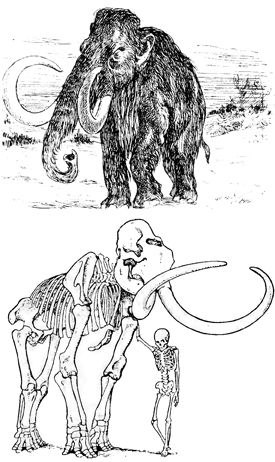
Fig. 1. Mammoth Mammuthus primigenius Blum.
Object – the death of the mammoth fauna complex.
Subject – the ascertainment of the role of human in the deaths of species of mammoth fauna complex on the example of determinant species – woolly mammoth Mammuthus primigenius Blum.
The historiography of the issue. Currently, there are several hypotheses about why at the end of the Pleistocene epoch, about 12 thousand years ago, many large mammals became extinct (they lived on all continents except Antarctica).
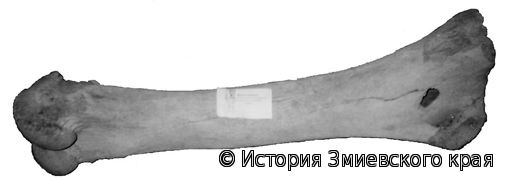
Fig. 2. Tibia of a mammoth Mammuthus primigenius Blum.
(Zamostya, Zmiev).
The version of the death of mammoths and other representatives of the faunal complex, which is interested to us as a result of a meteorite, is nominated before [10, p. 30; 31, p. 34], should be recognized as erroneous. Rock particles formed during heating are likely to originate from the fire instead of meteorite 12.9 thousand years ago. This is stated in the work of researchers from the University of California in Davis, published in the «Journal of Archaeological Science» [6].

Fig. 3. Tusk of a mammoth Mammuthus primigenius Blum.
(Mohnach village, Zmiev district).
According to the one of the original hypothesis extinction of the mammoths is suggested that they fell victim to a mineral deficiency. We are talking about “the geochemical model”, according to which due to a fundamental change of the geochemical landscapes in Warm glacial period (about 20 thousand years ago), when the glaciers gripped much of the North America, the Scandinavian Peninsula, the north of Europe and the East European Plain, the giant Pets are faced with a lack of macro- and micronutrients necessary for normal metabolism. That is a mineral famine came. However, as the P. V. Puchkov thinks (Shmalhausen Institute of Zoology, Ukraine), the hypothesis of the extinction of the mammoths cause of mineral deficiency contradicts many facts. Large and medium-sized herbivores (which include mammoths) inhabit almost all continental landscapes of the Earth, including disadvantaged in terms of one or more elements in the soil, water and feed. In particular, both types of elephants (African and Indian) spend a quite prosperous life in the mineral-deprived areas. In addition, according to the opinion of P. V. Puchkov “mineralnodefitsitnye” disease, which list the authors of the hypothesis, are not peculiar to the wild animals and are inherent only predominantly of highly productive breeds, besides imported in the unknown regions. Wild animals are not deprived of natural selection, are capable of physiological regulation of mineral metabolism. “Hardly mammoths surviving animals were less resistant to mineral deficiencies. The fact that they inhabited a vast territory of three continents, very heterogeneous in terms of the bedrock, climate and landscape, makes us think that their ability to the physiological, behavioral and evolutionary adaptation to the variations in the geochemical landscape is not inferior to that of modern elephants and ungulates” [17].
In the 60-ies of the 20th a hypothesis proposed by Ross MacPhee, curator of mammals at the Natural History Museum in New York. He suggested that the mammoths had destroyed some epidemic, or rather epizootic, as we are talking about animals. [19] The researcher had planned to find the evidence of his hypothesis by using subtle techniques of molecular biology to discover the remains of extinct giants or DNA and proteins of the pathogen alleged epizootic or antibodies to it. As we know, the hypothesis was not confirmed and found no further development.
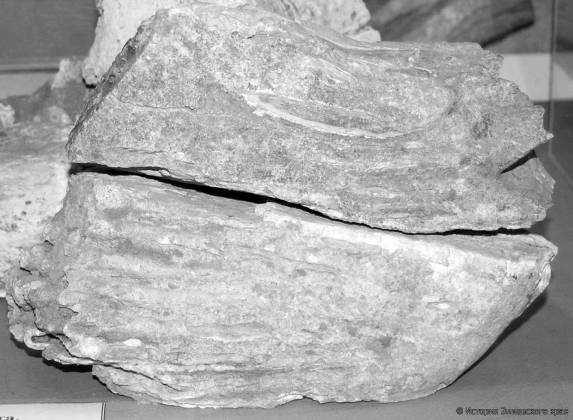
Fig. 4. Tooth of a mammoth Mammuthus primigenius Blum.
(the tract Lisya Balka, Zmiev district. 1952).
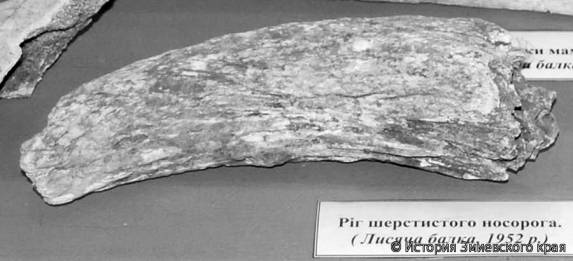
Fig. 5. Woolly rhinoceros horn Coelodonta antiquitatis Blum.
(the tract Lisya Balka, Zmiev district. 1952).
According to the verbal communication of Arthur A. Chubur «it is not the horn of a woolly rhinoceros, it is the horn of bisonin in this photo.The horn of a rhinoceros is made of keratin, that's why the fossil is preserved only in conditions of permafrost,so exactly south Vorkuta is impossible to find it. His bones is another matter -certainly thera are a lot of them on the territory of the Kharkiv region».
In the early 20th century the Copenhagen professor of zoology, geologist and archeologist J. Steenstrup hypothesized that people not only hunted mammoths, as is used in the food already dead and frozen animals [18]. Later this hypothesis was supported by V. A. Gorodtsov [11, p. 230-232], V. V. Dokuchaev [13, p. 1-54]. He developed the idea of “mammoth gathering” and added her arguments of V. I. Gromov [12, p. 403-405]. In particular, V. A. Gorodtsov and V. I. Gromov considered that all parking Paleolithic human were located near the “mammoth cemetery”. In the early works of a similar opinion was held by I. G. Pidoplichko and I. G. Shovkoplyas [30]. A researcher from the University of Illinois O. A. Soffer also considers the mammoth in the life of the Upper Paleolithic people like, first of all, the object of collecting, not hunting [25]. Recently, the hypothesis remains of the mammoth gathering support A. A. Chubur [27; 28; 29, p. 201-217]. At the same time, he considers the predatory destruction of entire herds of the mammoths idle fiction by the archaeologists Marxist [28, p. 160].
However, the main and the most old hypothesis about the causes of the extinction of the mammoth is the role of the Paleolithic hunters. For the first time this idea was expressed by Count A. S. Uvarov. After the establishment of the Soviet power and the beginning of the reign of the Marxist-Leninist methodology of this hypothesis was supported and developed by P. P. Efimenko, K. M. Polikarpovich, P. I. Boriskovsky [28, p. 205]. Later they were also joined I. G. Pidoplichko [20]. In the 21st century this view was supported by researchers from the University of Tübingen and the Senckenberg Society for the study of natural history (Germany) [3].
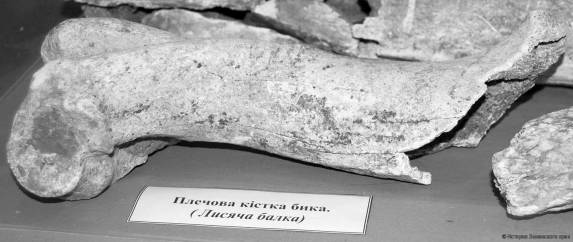
Fig. 6. Humerus of the wild ox Bos taurus primigenius L.
(the tract Lisya Balka Zmiev district. 1952).
Today is the only indisputable fact that where there was any human the mammoth survived. It is Wrangel Island (Siberia, Russia). There mammoths died out, probably due to the closure of the population. Appeared in the hands of paleontologists new research tool – the study of fossil DNA (results of the first sequencing of ancient woolly mammoth DNA was published in 1994), gave another look at this problem. With the end of the last Ice Age melting ice resulted in sea-level rise, and vast areas of Beringia was flooded. As a result, the Wrangel Island separated from the mainland, where there were isolated populations of the mammoth. This population became extinct according to the study authors only 3.7 thousand years ago. According to the first version, it was due to the fact that the island has become too small to support a viable population, but the results of genetic research led scientists to hypothesize the loss of genetic variability among the mammoths lived there, which led to their eventual disappearance. This view is contested by American paleontologist (University of Alaska, University of Uta, University of Anchorage) and E. N. Mashchenko (Paleontological Institute, Russian Academy of Sciences). On their data the island separated from the mainland by 5-6 thousand years ago and became extinct mammoths on it about 4.5 thousand years ago, i. e. the living there population lived in isolation only 1.5 thousand years, and during that time of significant changes in the genome could not occur [15]. In any case, the Wrangel Island – a separate and unique case, that cannot lay claim to a universal answer to the question about the reasons for the extinction of the mammoth on the planet as a whole.
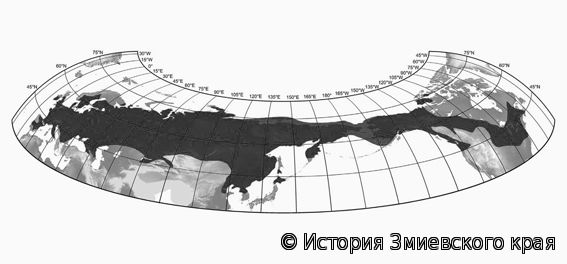
Fig. 7. The map of spreading the woolly mammoth
(According to Ralf-Dietrich Kalki).
So, in the historiography of the question of the causes of death of the mammoth to be divided into two, the most credible, in our view, the hypothesis: the immoderate hunting and climate change.
The aim of the article is to identify the role of Paleolithic human in the death of the mammoth fauna complex on the example of determining the species – the woolly mammoth Mammuthus primigenius Blum.
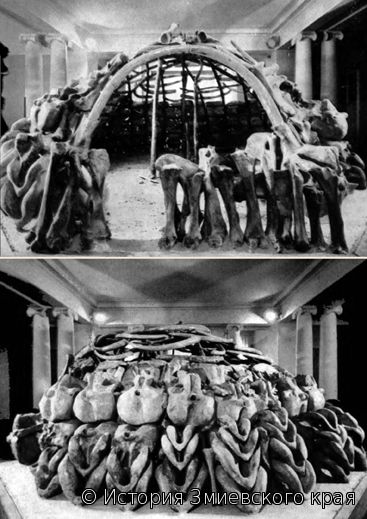
Fig. 8. The residence of the Paleolithic mhuan, built of the bones of the mammoths (reconstruction by I. G. Pidoplichko).
The statement of the basic material. Despite the diametrically opposite points of view on the causes of the death of this faunal complex, one thing is certain: the mammoth was the economic foundation of human existence in the Stone Age. For example, in the late Paleolithic spread the special type of construction the yarangovidnyh dwellings (huts) using the bones of the large animals, such as mammoths. Mammoths left as an imprint on the material and spiritual culture, that it is even reflected in the language material. So, for example, in Ukrainian, Russian, Belarusian, Polish and many others. Slavic languages the word Sula (Shula, oshula) and surelya (tsurelya) has two meanings: “column” and “big bone”. The root of the word Sula became the basis for words Masol (Mosul), meaning “big bone” and Sulitsa “spear” [21, p. 146, 147]. How was looked the Upper Paleolithic human habitation, built of the bones of mammoth, reconstructed I. G. Pidoplichko (Fig. 8).
Nothing is known about a way of hunting for mammoths. There are the images of mammoths, but there are any images of hunting for them. I. G. Pidoplichko [21, p. 148], N. K. Vereshchagin [9, p. 139-144] and others scientists assumed that there was a driving hunt. M. V. Anikovich, N. K. Anisyutkin and N. I. Platonov concluded that there was certain symbiosis of human and the mammoth in the Paleolithic, when the latest was almost domesticated animals. Researchers draw an analogy with the modern reindeer Rangifer tarandus L. In their opinion, the mammoth trusted people, which made it possible lure them directly to the camp, and slay sharp driving a wedge into the base of the skull, as did the mahouts elephants in ancient times, when they began to trample your own army [2, p. 132-133].
Y. B. Serikov having analyzed zoological, archaeological and ecological aspects of hunting for mammoths came to a new conclusion. The researcher rightly believes that the mammoth as the object of hunting is dangerous and hard vulnerable for the Paleolithic hunter. According to him, the analysis of the archaeological findings show that the human technical equipment was inadequate for effective hunting for the mammoths. At the same time aware of numerous “cemetery” of these animals. From there the numerous mammoth bones detected by archaeologists in Paleolithic encampments occur. Meat diet of the human included the other animal species. This statement in the light of the recent studies to be considered obsolete [4]. Summarizing, Y. B. Serikov states: “The hunting for the mammoths, and if it was, it had a very limited” [24, p. 10]. V. S. Yanovich, though without being an expert scientist, it is reasonable to note that the driving hunting for the mammoths could not take place because “they are terrible rage and resentment, inflicted one of the relatives, can crush the whole village” [32, p. 102]. This opinion has the right to exist because by G. P. Grigoriev calculations the Upper Paleolithic community consisted of 5-10 families and could put 5 to 25 hunters [8, p. 14]. It is not enough for hunting a herd of the mammoths. Therefore, V. S. Yanovych expressed the extravagant idea that hunting for the mammoth carried out during their sleep or hibernation [32, p. 102-103].
If hunting for this type of animal is practiced, it is likely that the Paleolithic hunters killed mammoths special spears tipped with mammoth tusks. The length of such lugs reached 0.5 m, and the thickness – of 2.5 cm [21, p. 148]. In any case, people hunted elephant before. For example, carriers archaeological Clovis hunted and ate the elephant-like animals from the family gomfothere (Gomphothere Cuvieronius sp.). The bones of now extinct animal found on the monument Fin del Mundo in the north-western Mexico [5].
One of the arguments of scale extermination of this animal is the amount of human bones found in the ruins of Paleolithic dwellings. According to estimates I. G. Pidoplichko for the construction of dwellings required (depending on the size of it) score of 18 to 95 mammoths. At least half, archaeologists discovered mammoth bones belonged to a young and semi-mature individuals. If we consider that this animal fertility rate is 0.08, the role of man in the death of the Eastern European mammoths becomes apparent. In the forest and steppe zones of Eastern Europe at the same time could be around half a million mammoths. Considering the analogy with the hunting of elephants (without the use of firearms), the number of the mammoths may have been destroyed in Eastern Europe for 200 years [21, p. 148]! A. A. Chubur denying the total extermination of the mammoths by human gives the following data. At stops Elisevichi, Avdeev, Yudinovo, Mezin, Suponevo, Timonovka, Hotylёvo 2 were found the remains of many tens or even hundreds of animals of different ages – from uterine mammoths until very old individuals [28, p. 157]. On a construction of one house spent the bones of 20-30 individuals of the mammoth [28, p. 206].
A necessary condition for the survival of primitive man was to meet daily needs for food and drink i. e., there was the direct dependence of the plant and animal resources, water sources. Changing paleoclimatic conditions reasoned the volatility of the availability of essential resources. The numerous climate changes directly affects the habitats, quantitative and qualitative composition of plant and animal communities, and thus the ability of the ancient man to provide biological resources. Their availability depended on the type of terrain, and seasonal dynamics of global climate changes. In different periods of time to ensure the possibility of human food resources were not the same. The basis of the Paleolithic diet was the protein foods. The question about the volume of plant food still remains known little. The peculiarities of the chemical composition of collagen in the bone remains of the Paleolithic hominids it found that the basis of the diet, most likely, were herbivorous animals [26, p. 47, 56]. This is probably determined the disappearance of many of them. According to archaeologists, given by V. N. Stepanchuk in the “menu” of the Paleolithic human were: Woolly Mammoth Mammuthus primigenius Blum., Woolly rhinoceros Coelodonta antiquitatis Blum., horse Equus latipes chosaricus V. Gromova, the European Pleistocene donkey Equus hydruntinus Regalia, saiga Saiga tatarica L., Bull Bos Taurus L., longhorned bison Bison priscus longicornis Boj., bison Bison bonasus L., giant deer Megaloceros Blum., red deer Cervus elaphus L. and reindeer Rangifer tarandus L., as well as moose Alces alces Gray, roe deer Capreolus Gray, chamois Rupicapra rupicapra L. [26, p. 56].
The researchers from Tübingen University, Brno (Czech Republic) and Brussels have analyzed the bones of humans and animals to the Paleolithic parking Prshedmosti to understand whether they ate the mammoths Mammuthus primigenius Blum. To answer these questions, scientists have made the analysis of the stable isotopes of carbon and nitrogen in the bones of animals and humans. Age bones “participate” in the study – 25-27 thousand years (calibrated date: 29,5-31,5 thousand years). The study showed that the meat of mammoth was a big part of the people diet. Regaling to eat the mammoth and wild animals – brown bears Ursus arctos L., wolves Canis lupus L. and wolverine Gulo gulo L. Lions while feed mainly reindeer Rangifer tarandus L. or musk ox Ovibos moschatus Zimm., as well as possible, Bison Bison bonasus L. Wolves but mammoth, ate actively horses Equus sp. The abundance of the mammoths in the “menu” of wild animals indicates the availability of the carcasses of these animals. Perhaps the animals ate parts of carcasses, abandoned by the hunters. Interestingly, in the diet of dog meat is a small fraction of the mammoths. Most of their “menu” is engaged in reindeer or musk ox, which has not been the staple food of their owners. The researchers note that similar behavior “dog owner” observed the indigenous northern peoples: they do not give the dogs food they love themselves. In addition, a small number of “Mammoth” in the diet of dogs indicates that they probably did not take part in the hunting for the beast. Perhaps the dog at that time was mostly rideable. In itself, this study does not eliminate the question of the possibility of hunting for the mammoths. And the human, and moreover wild animals may eat the carcasses of animals that died from other causes [4].
A. A. Chubur argues that “only the mammoth cemeteries would be the main and most reliable source of fuel and building materials in the center of the East European Plain in periglacial conditions during the Upper Palaeolithic” [28, p. 216]. However, the “core” does not mean “only” and does not rule out the hunting for the mammoths.
The supporters of the climate hypothesis of the mammoths’ death argue that as a result of a sharp increase in thickness of snow cover and thawing periodic characteristic of the climate of the final Paleolithic (13,5-10 thousand years ago), has considerably worsened the power of the mammoths and other herbivores. Thick wool of the mammoths, musk ox, woolly rhinoceroses, bison, calculated on a cold but dry climate, get wet during thaws. The subsequent freeze led to the freezing of wet wool and animal deaths [14, p. 78-79].
By the degree of adaptation of animals to survive in conditions of prolonged and intensive snow cover even distinguish separate groups of animals: hionofobov, hionevfrov and hionofilov. A. N. Formozov traces a clear picture of the relationship between the distribution of the snow cover and the spread of a particular group of animals. Thus, the critical value of snow for the saiga is 10 cm, while, for example, bull and deer – up to 50 cm. In the context of long-term and relatively thick snow cover (20-30 cm), difficulties in ensuring nutrition began to experience the animals which only induced transition to eating twig food (Kula horse). Thick snow cover prevents the feeding even reindeer. And the fact that the cover could be enough powerful and cover a large area, is indirectly confirmed by prevalence and power of loess sediments that are Podontsove as the snow carried by the glacier had ashes origin [26, p. 60].
However, the natural causes of the mammoths’ death are not universal even in Europe, not to mention the global scale. Researchers at the University of Tübingen and the Senckenberg Society for the study of natural history (Germany) studied the bones, teeth and tusks of mammoths Gravettskoy era (30,5-22 thousand years ago). The analysis showed that the climatic conditions, as well as food and water available to these giant herbivores, remained stable. However, the work that led Dr. Dorothy G. Drucker (and which was published in the journal Quaternary International), shows that the number of the mammoths was declined. Bones and tusks of the mammoths in Gravettskih layers to decrease their age getting smaller. In any case, this trend is observed in the Swabian Alb mountain range (south Germany) and in the valley of the Dordogne (south-west France). Exactly the findings from this region have focused new research. The scientists have analyzed the composition of stable isotopes in the bones of the mammoths, horses and deer. The ratio of isotopes of carbon, sulfur and nitrogen give an idea of the stability of the ecological niche of animals. All three showed essentially stable isotope ratio in Gravettskih layers. This means that the environment has changed a little. In the remains of horses from the Swabian Alb recorded a marked change in nitrogen isotope 15N. The concentration of this isotope in time is approaching levels found in the bones of the mammoths. According to the researchers, this means that the horse gradually occupy an ecological niche of the mammoths. To find out whether there are climatic reasons for identifying the process, the researchers measured the level of oxygen isotope 18O. Changes in the level of this isotope would indicate a change in climate, but they are not. According to Dorothy G. Drucker, “it is very likely that the reason for the reduction of the population of the mammoths in the south-west of Germany were the people” [3].
Thus, there is every reason to blame is the Stone Age hunters in killing mammoths, as well as the entire mammoth faunal complex. This idea was confirmed by the fate of his other representatives. In Verchnem Podontsove woolly rhinoceros Coelodonta antiquitatis Blum., represents one of the characteristic components of the mammoth fauna, appeared during the advance of the glacier. His alleged birthplace is Asia. Habitat of this species has been enormous: from the British Isles to China and Korea. Since Coelodonta antiquitatis Blum. it does not occur with the beginning Neolithic [1, p. 25, 28, 31, 34], there is reason to believe that this was killed by a human. In the Upper Pleistocene fauna was typical cave bear Ursus spelaeus Rosenm. et Heinroth. Contrary to popular belief about the ferocity of the “cave of the family” of animals, this kind of bear was a herbivore. It is relatively easy prey, both predators and omnivorous person. Due to the last cave bear was gone to the top of the Mesolithic [1, p. 50-51].
In other words, these species have disappeared in the area of human habitation. Coincidence is not only geographical, but also chronological. The death of the mammoth fauna complex is placed, in general, within the framework of the Stone Age. i. e., the extinction of the representatives of this complex comes amid improving the tools of human, his hunting skills, increasing the number finally. A group of the researchers led by Chris Sendomom analyzed a large amount of information from different regions of the world. They compared the time of the disappearance of 177 mammals (only animals reconstructed weighing more than 10 kg) since the appearance of human in their habitats, as well as information on climate change. The study covers the time between 132 thousand. Years ago (beginning of the last interglacial period) and 1 thousand years ago. At the same time, archaeologists and paleontologists have considered the information not only on the scale of individual continents, but also within individual countries [33]. An analysis of this data allowed the authors to conclude that the disappearance of the large mammals are more closely correlated with human migration than climate change. According to Chris Sendoma, “facts do strongly suggest that people have been a determining factor” [7].
The increase of a snowfall, as a factor in the death of the mammoth fauna disputes P. V. Puchkov (Schmalhausen Institute of Zoology, Ukraine). Mammoths, as stressed by the scientist, were bigger and stronger than any of ungulates (who survived). They had higher legs, sliding his fingers and submanual pillow can significantly change the width of the foot, making it easier for walking in deep snow and dirt in the thaw. Heavy Leather legs and hard hair saved from injury, the system deep grooves on the soles easier for walking on ice, and tusked beasts crushing crust motion and nutrition. In addition, contrary to the false allegations, herbivorous mammoths could easily switch to winter twig food. Animal giants were much more difficult prey, even for very strong carnivores than herbivores other survivors [17].
Conclusions. Taking into considerations given above arguments of the various hypotheses, the following should be noted. A number of facts allows today to talk about the death of the mammoth fauna complex (Mammoth and in particular) by the human fault. These facts are as follows:
- the human was able to hunt elephant [5];
- the human used the meat of mammoth for food [4];
- the human used all parts of the mammoth for its food and household needs [21];
- the disappearance of large mammals are more closely correlated with human migration than climate change [33];
- climate change were not strong enough to affect the death of the faunal complex [3].
You should also, in our view, be considered true assumption of V. Y. Seregina of collecting primitive human of the mammoth bones for construction and other household needs [23]. This, however, does not exclude the mammoth willingly among species.
Unfavorable for large animals climatic conditions of the Stone Age, no doubt exacerbated their situation, but they could not be decisive.
In the light of the foregoing, the question remains about the technology of primitive human hunting for the mammoths. It is thought that the active cooperation of archeology and natural sciences, as well as the development of the experimental archeology will answer this question.
LITERATURE
- Алексеева Л. И. Териофауна верхнего плейстоцена Восточной Европы (крупные млекопитающие) / Л. И. Алексеева. – М., 1990.
- Аникович М. В. Человек и мамонт в Восточной Европе : подходы и гипотезы / М. В. Аникович, Н. К. Анисюткин, Н. И. Платонова // Stratum plus. – 2010. – № 1. – С. 99–136.
- Антонов Е. Климат «оправдали» по делу об убийстве мамонтов / Е. Антонов // Наука и жизнь. – 12 февраля 2015. – Электронный ресурс : http://www.nkj.ru/news/25871/ (дата обращения 10.09.2015).
- Антонов Е. Люди каменного века не давали собакам мясо мамонтов / Е. Антонов // Наука и жизнь. – 27 ноября 2014. – Электронный ресурс : http://www.nkj.ru/news/25259/ (дата обращения 10.09.2015).
- Антонов Е. Люди Кловис охотились на родственников слонов / Е. Антонов // Наука и жизнь. – 22 июля 2014. – Электронный ресурс : http://www.nkj.ru/news/24700/ (дата обращения 10.09.2015).
- Антонов Е. Метеорит-убийцу мамонтов «отменили»? / Е. Антонов // Наука и жизнь. – 16 января 2015. – Электронный ресурс : http://www.nkj.ru/news/25652/ (дата обращения 10.09.2015).
- Антонов Е. Человека снова обвинили в истреблении мамонтов / Е. Антонов // Наука и жизнь. – 6 июня 2014. – Электронный ресурс : http://www.nkj.ru/news/24485/ (дата обращения 12.02.2015).
- Бибиков С. Н. Некоторые аспекты палеоэкономического моделирования палеолита / С. Н. Бибиков // Советская археология. – 1969. – № 4. – С. 5–22.
- Верещагин Н. К. Почему вымерли мамонты / Н. К. Верещагин. – Л., 1979.
- Войцеховский А. И. Виновница земных бед? / А. И. Войцеховский // Знак вопроса. – М., 1990. – Вып. 7.
- Городцов В. А. Археология Каменный период / В. А. Городцов. – М.; Пг., 1923. – С. 230-232.
- Громов В. И. Палеонтологическое и археологическое обоснование стратификации континентальных отложений четвертичного периода на территории СССР (млекопитающие, палеолит) / В. И. Громов // Труды Геологического института АН СССР. – М., 1948. – Серия геологическая. – Вып. 64. – С. 403–405.
- Докучаев В. В. Археология России. Каменный период. ТТ. I и II графа А. С. Уварова. 1881 / В. В. Докучаев // Труды Санкт-Петербургского общества естествоиспытателей XIII. – СПб., 1882. – Вып. 1. – С. 1–54.
- Залізняк Л. Л. Фінальний палеоліт. Мезоліт / Л. Л. Залізняк // Україна : Хронологія розвитку / А. В. Толстоухов, В. О. Зубанов. – К., 2008. – Т. 1. – С. 78–107.
- Зимина Т. Вымирание мамонтов – виновата ли генетика? / Т. Зимина // Наука и жизнь. – 24 октября 2007. – Электронный ресурс : http://www.nkj.ru/news/11370/ (дата обращения 10.09.2015).
- Зимина Т. Мамонты : и стол, и дом / Т. Зимина // Наука и жизнь. – 8 декабря 2006. – Электронный ресурс : http://www.nkj.ru/news/7412/ (дата обращения 10.09.2015).
- Зимина Т. Отчего исчезли мамонты? / Т. Зимина // Наука и жизнь. – 3 апреля 2007. – Электронный ресурс : http://www.nkj.ru/news/8863/ (дата обращения 10.09.2015).
- Обермайер Г. Доисторический человек / Г. Обермайер. – СПб., 1913.
- Отчего вымерли мамонты? // Наука и жизнь. – 2001. – № 5. – Электронный ресурс : http://www.nkj.ru/archive/articles/5923/ (дата обращения 10.09.2015).
- Пидопличко И. Г. О ледниковом периоде / И. Г. Пидопличко. – К., 1951.
- Пидопличко И. Г. Позднепалеолитические жилища из костей мамонта на Украине / И. Г. Пидопличко. – К., 1969.
- Саяний М. І. Зміївщина – Слобожанщини перлина / М. І. Саяний. – Х., 2009.
- Серёгин В. Я. Скопления мамонта на палеолитических поселениях / В. Я. Серёгин // Советская археология. – 1991. – № 4.
- Сериков Ю. Б. К вопросу об охоте на мамонтов / Ю. Б. Сериков, А. Ю. Серикова // Уфимский археологический вестник. – 2007. – Вып. 6–7. – С. 5–11.
- Соффер О. А. Экономика верхнего палеолита : продолжительность заселения стоянок на Русской равнине / О. А. Соффер // Российская археология. – 1993. – № 3. – С. 5–17.
- Степанчук В. Н. Нижний и средний палеолит Украины / В. Н. Степанчук. – Черновцы, 2006.
- Чубур А. А. «Мамонтовое собирательство» в бассейне Десны / А. А. Чубур // Природа. – 1993. – № 7.
- Чубур А. А. Палеолит Верхнего Поднепровья. История исследований, экономика, жилище, социум / А. А. Чубур. – Саарбрюкен, 2011.
- Чубур А. А. Расселение верхнепалеолитического человека в центре Русской равнины (географический аспект) : Автореф. дис. … канд. ист. н. / А. А. Чубур. – М., 1997.
- Шовкопляс І. Г. Супоневська палеолітична стоянка / І. Г. Шовкопляс // Археологія. – К., 1950. – Т. 4.
- Щербаков В. И. Где искать Атлантиду? / В. И. Щербаков // Знак вопроса. – М., 1990. – Вып. 9.
- Янович В. С. Великая Скифия : История докиевской Руси / В. С. Янович. – М., 2008.
- Sandom С. Global late Quaternary megafauna extinctions linked to humans, not climate change / Christopher Sandom, Søren Faurby, Brody Sandel, Jens-Christian Svenning // Royal society publishing. – URL : http://rspb.royalsocietypublishing.org/content/281/1787/20133254.full (access 10.09.2015).
SOURCE OF THE ILLUSTRATION
Fig. 1. Верещагин Н. К. Почему вымерли мамонты / Н. К. Верещагин. – Л., 1979.
Fig. 2. Zmiev Local History Museum. Photo by Yuriy A. Kolovrat-Butenko, 2007.
Fig. 3. Zmiev Local History Museum. Photo by Yuriy A. Kolovrat-Butenko, 2007.
Fig. 4. Y. I. Krasyuk Folc Local History Museum of Pervomayskoye gymnasia. Photo by Yuriy A. Kolovrat-Butenko, 2009.
Fig. 5. Y. I. Krasyuk Folc Local History Museum of Pervomayskoye gymnasia. Photo by Yuriy A. Kolovrat-Butenko, 2009.
Fig. 6. Y. I. Krasyuk Folc Local History Museum of Pervomayskoye gymnasia. Photo by Yuriy A. Kolovrat-Butenko, 2009
Fig. 7. Карта распространения шерстистого мамонта / Сост. Ральф-Дитрих Кальке (Зенкенбергская научно-исследовательская станция Четвертичной палеонтологии в Веймаре, Германия) : http://sivilink.ru/karta-rasprostraneniya-sherstistogo-mamonta/
Fig. 8. Пидопличко И. Г. Позднепалеолитические жилища из костей мамонта на Украине / И. Г. Пидопличко. – К., 1969.
Fig. 2. Zmiev Local History Museum. Photo by Yuriy A. Kolovrat-Butenko, 2007.
Fig. 3. Zmiev Local History Museum. Photo by Yuriy A. Kolovrat-Butenko, 2007.
Fig. 4. Y. I. Krasyuk Folc Local History Museum of Pervomayskoye gymnasia. Photo by Yuriy A. Kolovrat-Butenko, 2009.
Fig. 5. Y. I. Krasyuk Folc Local History Museum of Pervomayskoye gymnasia. Photo by Yuriy A. Kolovrat-Butenko, 2009.
Fig. 6. Y. I. Krasyuk Folc Local History Museum of Pervomayskoye gymnasia. Photo by Yuriy A. Kolovrat-Butenko, 2009
Fig. 7. Карта распространения шерстистого мамонта / Сост. Ральф-Дитрих Кальке (Зенкенбергская научно-исследовательская станция Четвертичной палеонтологии в Веймаре, Германия) : http://sivilink.ru/karta-rasprostraneniya-sherstistogo-mamonta/
Fig. 8. Пидопличко И. Г. Позднепалеолитические жилища из костей мамонта на Украине / И. Г. Пидопличко. – К., 1969.
© Yuriy A. Kolovrat-Butenko, 2016
© Daria I. Bedner, 2016
© Daria I. Bedner, 2016
Link to this article (ссылка на эту статью):
Kolovrat-Butenko Yu. A. The role of human of the stone age in the death of the mammoth faunal complex / Yuriy A. Kolovrat-Butenko, Daria I. Bedner // История Змиевского края. – Змиев. – 28.01.2016. – URL: https://colovrat.at.ua/publ/1-1-0-292
Kolovrat-Butenko Yu. A. The role of human of the stone age in the death of the mammoth faunal complex / Yuriy A. Kolovrat-Butenko, Daria I. Bedner // История Змиевского края. – Змиев. – 28.01.2016. – URL: https://colovrat.at.ua/publ/1-1-0-292
Библиовебографическое описание (ДСТУ 8302:2015):
The role of human of the stone age in the death of the mammoth faunal complex // История Змиевского края. 29.01.2016. URL: https://colovrat.org/publ/1-1-0-292 (дата обращения: 23.12.2025).
Похожие статьи:
Рубрика: История Змиевщины | Дата публикации: 29.01.2016 | Просмотров: 48493 | Ключевые слова:
Рубрики
История Змиевщины [139]
Биографиcтика [67]
Славянское язычество [15]
Публицистика [15]
Зелёное движение [7]
Открытые письма [3]
Антифашизм [8]
День в истории
Новости Змиевского края
Новые поступления книг
Новые фотографии
Новые поступления карт
Новые объявления